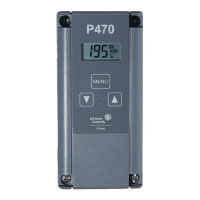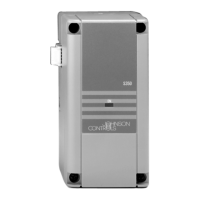Basic Controls—P352PN Electronic Proportional Plus Integral Pressure Controls for PSI Applications
3
Proportional-Only Controls
Proportional-only controls work by continuously
adjusting the magnitude of the control’s output signal in
proportion to the difference (input-error) between the
control’s setpoint value and the actual value sensed in
the controlled system. As load on a system increases,
the input-error to the control increases. The control
reacts by increasing the magnitude of the output
signal, driving the controlled device to respond to the
increased load. (See Figure 3.)
The advantages of proportional-only controls are that
they are easy to set up and adjust, and they provide
good stability and rapid response to changing load
conditions.
A disadvantage of proportional-only controls is they
can not maintain a system process at the exact control
setpoint. A proportional offset (or droop) is always
present when there is a steady load on the controlled
system. (See Figure 3.)
The result is that a proportional-only control maintains
a system process at a control-point instead of the
desired setpoint. Control-point is setpoint plus the
proportional offset. The greater the load on the system,
the greater the proportional offset and the further the
control-point is from the system setpoint. A
proportional-only control can not adjust the output
signal to drive a system process from the control-point
to the desired setpoint. (See Figure 3.)
Systems with proportional-only controls and large
loads or highly variable load conditions may operate at
control-points that vary significantly from the desired
setpoint.
Proportional Plus Integral Controls
The P352PN proportional plus integral (PI) pressure
control incorporates integral (or reset) control action
along with proportional-only control action. The
advantage to this is that the PI design effectively
eliminates proportional offset, and the PI control can
adjust the output signal to not only match a steady load
on the system, but also drive the system process
towards setpoint. On a properly sized system with
steady load conditions, a PI control can maintain the
system process very close to the system setpoint. (See
Figure 3.)
The speed at which the PI control drives the system
process to setpoint (recovery rate) is determined by
the system’s capacity, the size of the load, and the
integration constant set on the PI control.
The integration constant establishes the rate at which
the control re-adjusts to the load as it drives the
process towards setpoint. The faster the integration
constant, the faster the control re-adjusts the
magnitude of the output signal, and the faster the
recovery rate of a properly sized and setup system.
On traditional PI controls, the rate of re-adjustment can
become too large if the process load exceeds the
capacity of the equipment. When the controlled
equipment is at full capacity and the setpoint still
cannot be reached, traditional PI controls continue to
readjust the magnitude of the output signal. The result
is called
integral windup
.
The P352PN Series proportional plus integral controls
avoid
integral windup
with a patented circuit that puts a
dynamic ceiling on the integrator, which allows the
process to recover from an out-of-range condition
without experiencing a long period of overshoot.
It should be noted that PI controls might not be suitable
for all applications. Improperly applied PI controls may
be unstable and overshoot setpoint.
Also, PI controls require two separate adjustments that
are dependent on each other. The system must be
properly sized to handle the maximum process load,
and close observation is necessary when the PI
controls are initially set up and checked out. But on the
proper applications PI controls provide superior
accuracy and continuous setpoint control.

